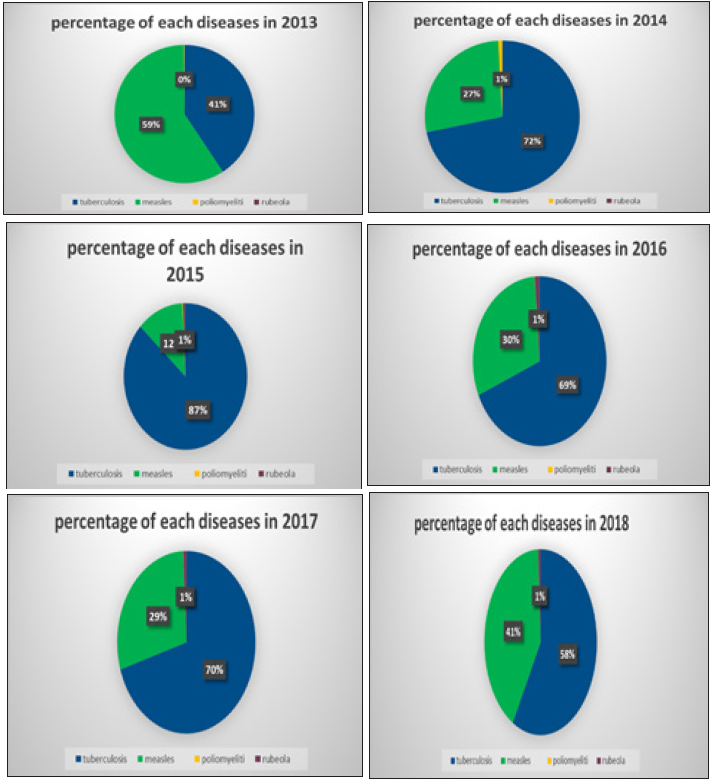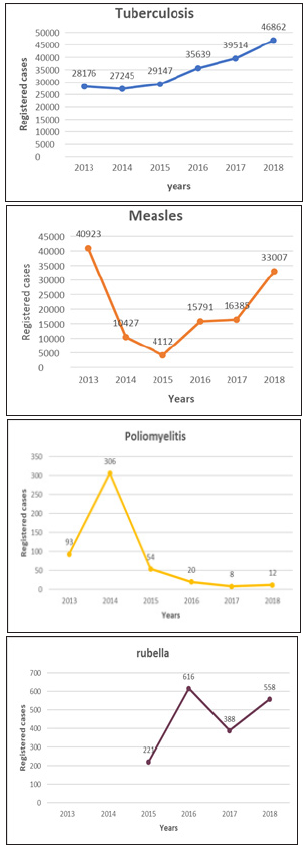- Submissions

Full Text
Open Access Biostatistics & Bioinformatics
Comparison of Tuberculosis, Measles, Poliomyelitis and Rubella on Children Aged Less than 15 in a Poor Country: Case of the Republic of Pakistan
İlker Etikan* and Vidal FYG
Near East University, Faculty of Medicine, Department of Biostatistics, Nicosia TRNC, North Cyprus
*Corresponding author: İlker Etikan, Near East University, Faculty of Medicine, Department of Biostatistics, Nicosia-TRNC, North Cyprus
Submission: January 29, 2020;Published: February 20, 2020

ISSN: 2578-0247 Volume2 Issue5
Abstract
We compared Measles, Tuberculosis, Poliomyelitis and Rubella infectious diseases in Pakistan on children aged less than 15 years from 2013 to 2018. We collected the registered cases of each disease per years at the World Health Organization (WHO) and at the United Nation International Children Emergency Fund (UNICEF) website and we used SPSS program to calculate descriptive statistics and plot graphics. We find out that over the past six years, among the four infectious diseases studied, Tuberculosis and Measles were the most present among children aged fewer than 15, their mean over the years was respectively 34430.50 and 20107.50, and their percentage was around 50% Of the whole studied diseases. Rubella and Poliomyelitis were the less infectious disease present among children aged under 15 in Pakistan from 2013 to 2018, their mean over the years was respectively 178.35 and 114.28, and their percentage was around 1% of the whole studied infectious diseases. Furthermore, Away from Poliomyelitis which curve was mostly decreasing over the last six years, all the three other diseases, Tuberculosis, Measles and Rubella had a curve mostly increasing over the last six years.
Keywords: Measles; Tuberculosis; Poliomyelitis; Rubella; Deaths cases; UNICEF
Introduction
Infectious diseases are disorder in our organism caused by pathogen agents such as bacteria, viruses, parasites or fungi. Their diversity is closely related to the causal organism, and we can mention among others: viral infectious diseases (measles, poliomyelitis, rubella), bacteria infectious diseases (tuberculosis), fungi infectious diseases (valley, fever). Some infectious diseases are classified or also known as communicable diseases; meaning that after contracted by a person or population it can be transferred to a healthy person/population; that’s what give to some of them their epidemiological impact. Generally infectious diseases can be transferred to each other by skin contact, contact with faces, bodily fluids, infected object and airborne particles [1]; and the most common on childhood are bronchiolitis, glue ear, rotavirus, measles, poliomyelitis, tuberculosis, rubella [2]. The harmful characteristic of infectious diseases (transferability) make them a real problem for developing countries. A developing country is a country where the educational, economic and socio-cultural level is very low. Many instruments as HDI (Human Development Index) is used to range country according to their development status. The International Monetary Fund classify a country as low developed when 0<HDI<0.55, medium developed when 0.55<HDI<0.70, high developed when 0.70<HDI<0.80 and high developed when 0.8<HDI<1 [3,4].
Some infectious diseases are a real worldwide problem and countries are taking different preventative measures (vaccination in the most case) to irradiate them or to limit their impact; but developing countries (Nigeria, Afghanistan, Pakistan) still find it difficult to attend this objective [5-7]. The World Health Organization (WHO) classify the Pakistan among the top five countries with the most reported cases of measles, tuberculosis, poliomyelitis and rubella. Therefore, our study objective was the comparison of Pakistan infectious diseases (case for measles, poliomyelitis, tuberculosis, and rubella) on children aged under 15 years old. A good way to see the impact of each of these diseases, and a way to see the extent of work to be given to each of them for its complete irradiation [7-10].
Method
Study design, participants and data collection
We performed a descriptive study between 2013 and 2018 in Pakistan. Pakistan was choose as the developing country in our study in accordance to his HDI in 2017 (0.562); the studied population included the registered cases of measles, tuberculosis, poliomyelitis and rubella infectious diseases on children aged under 15 years in the country; These was obtained through the WHO and United Nation International Children’s Emergency Fund (UNICEF) website.
Statistical method analysis
We performed a descriptive statistic of the different variables using SPSS and Microsoft Excel to compare the registered case of each diseases per years, and to compare the evolution of the registered cases case with respect to the vaccination coverage.
Result
The central tendency of each diseases reported cases from 2013 to 2018 reveal us that, concerning Tuberculosis, the minimum of registered cases was 27245, the maximum was 46862, the mean and the standard deviation was 34430 and 7752.55; for Measles, the minimum of registered cases was 4112, the maximum was 40923, the mean and standard deviation was 20107 and 14012; for poliomyelitis, the minimum was 8, the maximum was 306, the mean and standard deviation was 82.17 and 114.28; for Rubella, the minimum was 221, the maximum was 616 the mean and standard was 445.75 and 178.35 (Table 1 & 2). We also plotted the bar graph and the Pie chart for each infectious disease per years to determine the proportion and the frequency of each disease every year. Tuberculosis and Measles had the highest proportion each year, always around 50% and also the highest number of reported cases; In 2013, between the two diseases, measles had the higher number of reported cases and of course the highest percentage, but from 2014 to 2018 tuberculosis had the highest number of reported case and the higher percentage. Poliomyelitis and Rubella had the lowest proportion, always around 1% and the lowest number of reported cases; From 2013 to 2014 Rubella cases was not registered and Poliomyelitis was higher than Rubella according to the data, but from 2015 to 2018 Rubella registered cases and percentage was higher than Poliomyelitis (Figure 1-3).
Figure 1: Reported cases of each disease per years.

Table 1: Tuberculosis, Measles, Poliomyelitis and rubella reported cases in Pakistan from 2013 to 2018.

NA: Not Available
Table 2: Central tendency of the different diseases reported cases from 2013 to 2018.

N: Number of Observations; Std: Standard deviation
Figure 2: Percentage of each disease each year.

Figure 3: Evolution of each diseases over the years.

Furthermore, we plot the line graph of each disease to see their evolution over the years. We observed that Tuberculosis registered cases decreased from 28176 in 2013 to 27245 in 2014, then increased over the years from 2014 until reached 46862 in 2018; the lowest value of tuberculosis registered case was in 2014, and the highest value was in 2018. Measles registered cases decreased from 40923 in 2013 to 4112 in 2015, then increased from 4112 in 2015 to 33007 in 2018; the lowest value was in 2015 and the highest value was in 2013. Poliomyelitis registered cases increased from 93 in 2013 to 306 in 2014, then dropped significantly over the years from 2014 to 2017, moving from a value of 306 to 8, and later increased from 8 to 12 in 2018. The lowest value of Poliomyelitis registered case was in 2017 and the highest value was in 2014. Rubella registered cases increased from 221 in 2016 to 616 in 2018, then decrease from 616 to 388 in 2017, and increased again from 388 in 2017 to 558 in 2018. The lowest value of Rubella registered cases was in 2015 and the highest value was in 2018.
Discussion
On average over the years 2013 to 2018, tuberculosis was the childhood disease most present in the country with an average of 34430.50 over the years; its follow by measles with an average over years equal to 20107; the less present were Rubella and Poliomyelitis with respective average of 445.75 and 82.17 over the years. Furthermore, each year, from 2013 to 2018, Tuberculosis and Measles were the more present infectious diseases among children under 15 years in Pakistan regardless their reported cases and their percentage. Rubella and Poliomyelitis was the infectious diseases less present in the country each year. Away from Poliomyelitis with a curve mostly decreasing over the last six years, all the three other diseases, Tuberculosis, Measles and Rubella have a curve mostly increasing over the last six years. All this implies that, Pakistan, on a descending scale of problem of infectious disease (Measles, tuberculosis, Poliomyelitis and Rubella to our case) to solve on the population aged under 15 years old, have at the top Tuberculosis then Measles, after Rubella and at the end Poliomyelitis [10-15].
References
- (2019) WHO library cataloguing-in-publication data global tuberculosis report 2015. Geneva, Switzerland.
- (2019) Childhood diseases: Measles, mumps, & more. Accessed.
- Rubella cases by country by month (1).
- (2019) Global Tuberculosis Report 2017. World Health Organization, Geneva, Switzerland, p. 262.
- Mere MO, Goodson JL, Chandio AK, Rana MS, Hasan Q, et al. (2019) Progress toward measles elimination-Pakistan, 2000-2018. MMWR Morb Mortal Wkly Rep 68(22): 505-510.
- (2019) Member t. Meeting of the technical advisory group (tag) on polio eradication in Pakistan.
- (2019) Global Tuberculosis Report 2018.
- (2019) Polio cases in Pakistan. Geneva, Switzerland.
- (2019) Infection: Types, causes, and differences.
- (2016) WHO, Geneva, Switzerland.
- (2014) Global Tuberculosis Report.
- (2019) Underdeveloped Countries.
- (2019) Human Development Reports.
- (2019) WHO | Measles and rubella surveillance Data. Geneva, Switzerland
- (2019) WHO, Geneva, Switzerland. pp. 1-1415.
© 2020 İlker Etikan. This is an open access article distributed under the terms of the Creative Commons Attribution License , which permits unrestricted use, distribution, and build upon your work non-commercially.
 a Creative Commons Attribution 4.0 International License. Based on a work at www.crimsonpublishers.com.
Best viewed in
a Creative Commons Attribution 4.0 International License. Based on a work at www.crimsonpublishers.com.
Best viewed in 







.jpg)






























 Editorial Board Registrations
Editorial Board Registrations Submit your Article
Submit your Article Refer a Friend
Refer a Friend Advertise With Us
Advertise With Us
.jpg)






.jpg)














.bmp)
.jpg)
.png)
.jpg)










.jpg)






.png)

.png)



.png)






